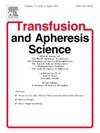51岁受精卵孕妇红细胞抗体的发生和消失及其妊娠结局
IF 1.2
4区 医学
Q4 HEMATOLOGY
引用次数: 0
摘要
在高龄妊娠供体卵子(DO)受体中,与多种红细胞同种异体抗体相关的并发症,包括胎儿和新生儿溶血性疾病(hhdn)和识别相容的红细胞(RBC),对输血医学来说是一个挑战,特别是在同种异体抗体消失的紧急情况下。在这里,我们报告了一名51岁的妇女接受了三个周期的体外受精,使用她丈夫精子的胚胎和匿名DO。妊娠期间检测到抗ce和抗jka同种异体抗体,妊娠晚期抗jka消失,分娩后再次诱导。产后出血1200 ml,经上海血液中心筛选Rh和基德相容红细胞2单位800 ml输注。新生儿出现中度HDFN,并接受光疗和静脉注射免疫球蛋白治疗。本文章由计算机程序翻译,如有差异,请以英文原文为准。
The development and evanescence of red blood cell antibodies in a 51-year-old pregnant ovum recipient and her pregnancy outcome
Management of complications, including hemolytic disease of the fetus and newborn (HDFN) and identifying compatible red blood cell (RBC) for future transfusions, related to multiple RBC alloantibodies in extremely advanced age pregnant donor ovum (DO) recipient is a challenge for transfusion medicine, especially during emergencies when alloantibodies become evanescent. Here we reported a 51-year-old woman underwent three cycles of IVF using embryos from her husband sperm and anonymously DO. She was detected with anti-Ce and anti-Jka alloantibodies during the pregnancy, with anti-Jka becoming evanescent in the third trimester and reinduced after delivery. She had a postpartum hemorrhage of 1200 ml blood loss and transfused 2 units of 800 ml Rh and Kidd compatible RBC screened by Shanghai Blood Center. The newborn experienced moderate HDFN and was treated with phototherapy and intravenous immune globulin.
求助全文
通过发布文献求助,成功后即可免费获取论文全文。
去求助
来源期刊
CiteScore
3.60
自引率
5.30%
发文量
181
审稿时长
42 days
期刊介绍:
Transfusion and Apheresis Science brings comprehensive and up-to-date information to physicians and health care professionals involved in the rapidly changing fields of transfusion medicine, hemostasis and apheresis. The journal presents original articles relating to scientific and clinical studies in the areas of immunohematology, transfusion practice, bleeding and thrombotic disorders and both therapeutic and donor apheresis including hematopoietic stem cells. Topics covered include the collection and processing of blood, compatibility testing and guidelines for the use of blood products, as well as screening for and transmission of blood-borne diseases. All areas of apheresis - therapeutic and collection - are also addressed. We would like to specifically encourage allied health professionals in this area to submit manuscripts that relate to improved patient and donor care, technical aspects and educational issues.
Transfusion and Apheresis Science features a "Theme" section which includes, in each issue, a group of papers designed to review a specific topic of current importance in transfusion and hemostasis for the discussion of topical issues specific to apheresis and focuses on the operators'' viewpoint. Another section is "What''s Happening" which provides informal reporting of activities in the field. In addition, brief case reports and Letters to the Editor, as well as reviews of meetings and events of general interest, and a listing of recent patents make the journal a complete source of information for practitioners of transfusion, hemostasis and apheresis science. Immediate dissemination of important information is ensured by the commitment of Transfusion and Apheresis Science to rapid publication of both symposia and submitted papers.

 求助内容:
求助内容: 应助结果提醒方式:
应助结果提醒方式:


